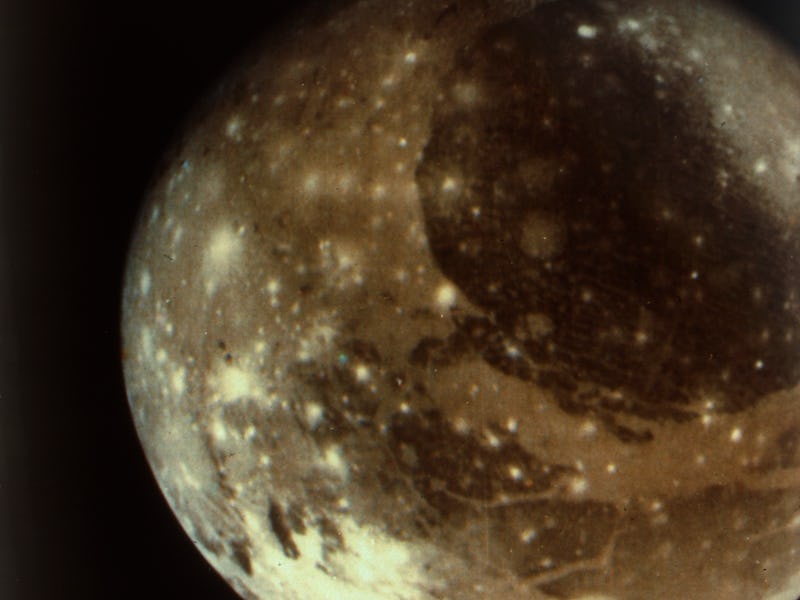Listen: NASA probe captures "wild" sounds from the Solar System's largest moon
Juno just picked up some odd frequencies at Ganymede, Jupiter's largest moon.

NASA’s Juno spacecraft recently made a close pass by the largest moon in the solar system, and it came away with a unique — and eerie — souvenir.
As Juno zipped by Jupiter’s moon Ganymede, it tuned its radio and plasma instruments to the icy satellite. Pitch-shifted into audible frequencies, the result is an audible account of the spacecraft’s journey and a valuable trove of data on the moon’s properties.
Juno first entered orbit around Jupiter in July 2016 and has made more than 30 trips around the planet since then. The spacecraft’s numerous instruments have peered deep into the Solar System’s largest and most massive planet, gathering new insights about Jupiter’s roaring winds, stunning aurorae, interior composition, and more. Now, with its main mission over, Juno is looking outward to some of Jupiter’s moons.
Ganymede was last visited more than 20 years ago by the Galileo mission, which discovered the moon has its own magnetic field — the only natural satellite known to have one. Ganymede also likely contains vast, salty oceans under a shell of ice, in addition to a rocky mantle and an iron-rich core.
Those oceans might be divided into a kind of sandwich of alternating water and ice layers, scientists think, with deeper ice crushed into denser and more exotic forms. These oceans may also be one of the best places to look for alien life in the Solar System, and future missions to Ganymede and other icy moons may dive beneath their surfaces to find out. But for now, Juno is providing a long-awaited update on the Solar System’s biggest moon (larger than the planet Mercury), including new data on its unique magnetic field.
The spacecraft came within 645 miles of Ganymede on its flyby, hurtling past at more than 41,000 miles per hour. As it did, the Juno team attuned the Waves instrument to the radio and plasma waves generated by the magnetic interactions between Ganymede and Jupiter. By turning the resulting data into sound waves that humans can hear, the Juno team has given us the chance to listen to the largest moon in the solar system, a kind of celestial soundtrack.
The 50-second-long clip begins with some very sci-fi-sounding bleeps and bloops that quickly give way to a steadily rising howl, like the rush of an enormous wind. The onslaught of noise, actually a barrage of electrical and magnetic waves, increases in pitch as Juno speeds toward Ganymede and — just as you might be bracing for impact — crests and recedes.
“This soundtrack is just wild enough to make you feel as if you were riding along as Juno sails past Ganymede for the first time in more than two decades,” Scott Bolton, Juno principal investigator at the Southwest Research Institute in San Antonio, said in a statement.
The researchers picked up something interesting within the signal: a sudden increase in frequency as Juno flew into a different part of Ganymede’s magnetosphere. Though they’re still processing the data, the team thinks it could correspond to when the spacecraft passed from the moon’s nightside to dayside.
The Juno team announced the soundtrack as part of a more extensive presentation at the American Geophysical Union’s Fall Meeting. Among other things, they unveiled the most detailed map to date of Jupiter’s magnetic field and models of the dynamics of its atmosphere, as well as high-resolution data on Ganymede’s icy shell.
The magnetic map included new insights into what’s known as the “Great Blue Spot” on Jupiter, a mysterious magnetic anomaly at the planet’s equator. Unlike the Great Red Spot, which is a hurricane larger than Earth, the Great Blue Spot is composed of warped magnetic field lines, and is invisible to the naked eye.
Juno’s magnetic imaging instruments found this region of mysterious magnetism is drifting eastward at a steady clip of two inches per second, and being pulled steadily apart by the jet stream-like zonal winds that circle the planet. It’s a sign these jet streams reach deep into the planet’s interior, the Juno team says.
Looking to Ganymede, members of the Juno team looking at the moon’s icy surface say they were able to gather new data on the composition of the ice both above and below the surface. Among their findings was that the ice beneath the surface varies from location to location, hinting at greater complexity inside the moon than was previously thought. These observations and more mean we’re closer to understanding this icy world, both inside and out.
This article was originally published on